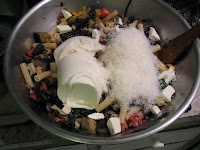Like that recipe, every Filipino mother has her own version but they don't vary a whole lot. Most just simmer the chicken in the sauce and call it done, flabby skin and all, but I really liked the ones that removed the meat and cooked it up crisp. A grill would likely be ideal, but I'm going to use my broiler (I'm writing as the chicken marinates, another unusual step). The most unusual aspect of this recipe is the inclusion of coconut milk. Almost nobody does that, but it seems like a good idea. I think that's what the "sa gata" means in the recipe name, but Babelfish finds the term confusing so I'm not sure.
I did a little research and found that the recipes on the web that include coconut milk can all be traced back to Memories of Philippine Kitchens, a cookbook by Amy Besa and Romy Dorotan. Coconut milk is, according to the book (according to a blogger who read the book, anyway) traditional in the Bicol region of the Philippines. I'm going to assume this is a regional variation.
I made a few changes away from the version in Memories based on some other recipes I found interesting.
Ingredients:
1 3 1/2 pound chicken, cut into serving pieces, liver and heart included and fat trimmed
1/4 cup light soy sauce

1/4 cup dark soy sauce
1/2 cup white vinegar [If you've got proper Filipino soy sauce and vinegar, definitely use that instead as this is just an approximation]
3/4 cup coconut milk
4 cloves garlic, crushed
1 sizable shallot, minced
2 bay leaves
generous ground black pepper [or double that whole peppercorns if you want to avoid black specks in your sauce]
1. Mix up everything but the chicken in a large bowl. Add the chicken and marinate in the refrigerator for 3 hours to overnight.
2. Move
 everything to a large pot (I marinated in my slow cooker pot and cooked it in there instead of the stovetop) and simmer the chicken over medium heat until mostly done, probably around 20 minutes. [Some recipes let the pot cool and refrigerate overnight before finishing the dish. It couldn't hurt if you've got the time.]
everything to a large pot (I marinated in my slow cooker pot and cooked it in there instead of the stovetop) and simmer the chicken over medium heat until mostly done, probably around 20 minutes. [Some recipes let the pot cool and refrigerate overnight before finishing the dish. It couldn't hurt if you've got the time.]3. Remove
 and drain the chicken. Broil 4 inches away from the heat, skin-side up, turning the pieces with skin on both sides, until crisp and a bit charred. Mine went for 6 minutes but I left them in the pot a little long so take the chicken out sooner and go for 10.
and drain the chicken. Broil 4 inches away from the heat, skin-side up, turning the pieces with skin on both sides, until crisp and a bit charred. Mine went for 6 minutes but I left them in the pot a little long so take the chicken out sooner and go for 10.4. Strain the sauce into a pot and reduce a bit. Add more coconut milk to taste.
Serve with white rice, sauce on the side.

Hmm...not bad at all. The chicken weathered the broiler without drying out. It's juicy and has picked up a bit of flavor from the sauce but not enough to overwhelm the mild flavor of the meat. The skin has some crisp bits, but could have stood a little more broiling. Still good through.
The sauce has pleasant levels of salty and tart, moderated by the slightly sweet richness of the coconut milk. A bit of herb comes through from the bay too, but not enough to really assert itself. It's a bit of an odd combination and I wonder if I was supposed to use Indian bay, which goes a bit better with soy sauce to my mind. I should check on that.
I reduced the sauce a bit more to intensify the flavors after I had dinner and then added a little more of the thick bit of the coconut milk--condensed coconut oil mainly--which mounted the sauce nicely like adding butter to French sauce. I think next time, I might not cook with the coconut milk, just add it at the end. I'm curious what sort of difference it might make.
One last thing, one recipe I saw called for a small chicken plus four chicken livers. I wasn't sure what that was about until I tried the liver I cooked and discovered that it was really great. The flavor is a great match for the sauce, better than just plain chicken by a bit. If you could crisp it up in the oven I'd make this with just livers.






























